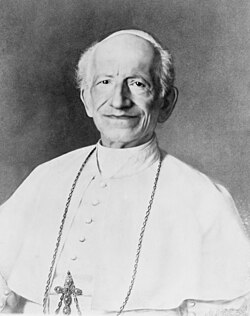Quamquam pluries
 Quamquam pluries is an encyclical on Saint Joseph by Pope Leo XIII. It was issued on August 15, 1889 in Saint Peter's Basilica in Rome. Saint JosephLeo XIII presented Saint Joseph as a model at a time when the world and the Church were wrestling with the challenges posed by modernity.[1] With the encyclical Quamquam pluries, Leo XIII was the first pope to draw the lines of a theology of Saint Joseph, with clearly defined titles that fit into the history of salvation, of human redemption, both at the level of the incarnation, as husband of Mary and father of Jesus, and at the level of the Church's life, as its natural protector.[2] The pope stated the challenges facing the Church and urged Catholics to pray to Saint Joseph, as the patron of the Church:
Labor as a vocationLeo was concerned with the industrial capitalism of the end of the nineteenth century and its treatment of workers. According to D. Stephen Long, Pope Leo "viewed labor not as a mere commodity subject to free competition, but as a dignified vocation."[4] Referring to Saint Joseph, Pope Leo wrote, "[h]e set himself to protect with a mighty love and a daily solicitude his spouse and the Divine Infant; regularly by his work he earned what was necessary for the one and the other for nourishment and clothing"[3] Pope Leo saw the family as the foundation of Christianity and society, therefore, a wage sufficient to support the family was essential.[5] Long explains that the Holy Family provides an example of the dignity of labor and the obligation of the employer to provide a living-wage. Leo opposes both capitalism's infringement on the family and socialism's call for common ownership.[4] It is a subject Leo would expand upon two years later in Rerum novarum. The pope then prescribed that during October, a prayer to Saint Joseph be added to the Rosary[6] and granted an indulgence of seven years and seven Lents for each such act; the prayer remains enriched with a partial indulgence in the current Enchiridion Indulgentiarum. See alsoReferences
External links |
||||||||||||||||||||||||||















